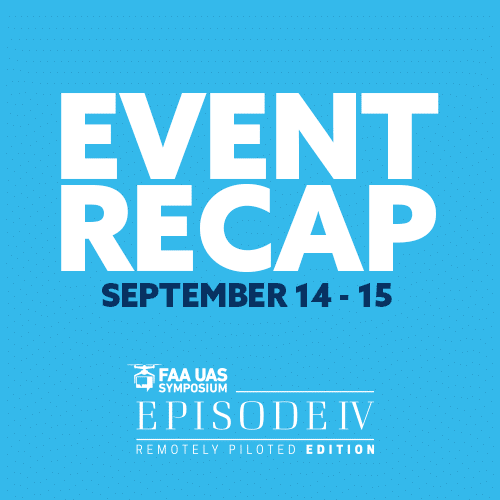UAS Symposium Episode IV: Updates on BVLOS, Operational Approvals, and More
September 16, 2021 | AUVSI News

This week, the Federal Aviation Administration (FAA) and AUVSI hosted the Episode IV of the UAS Symposium – Remotely Piloted Edition. The event brought together the unmanned aerial systems (UAS) community at a pivotal moment, which much is happening from new rules on remote identification to a focus on beyond visual line of sight (BVLOS) operations, all under a backdrop of the increased use of drones for humanitarian purposes and COVID-19 pandemic response.
The final segment of this virtual event series fostered discussions on how the UAS industry is doing more than ever with new technologies and uses. Below are top takeaways from the event for the UAS community.
Updates from the BVLOS Aviation Rulemaking Committee (ARC)
Throughout multiple sessions discussing the key challenges and pivotal topics that have emerged during the BVLOS ARC, representatives described their expectations as “hopeful” that the Committee’s work will lead to regulations that enable routine BVLOS operations.
Jay Merkle, Executive Director of FAA’s UAS Integration Office, revealed that the ARC rollout timing was planned so that it could be launched as soon as FAA’s Remote ID rule was finalized. He reiterated that the ARC’s goal is to provide recommendations to FAA by the end of the year, moving more quickly than prior ARCs to keep pace with the UAS industry’s needs. Merkle anticipates that resulting BVLOS rulemaking will present a significant step forward in routine, advanced drone operations, including delivery via drone.
Eric Bergesen, UPS Flight Forward’s representative on the ARC, stated that he anticipates the final report on the industry will provide useful information to Congressional committees and other federal regulatory agencies in addition to FAA.
Panelists reminded attendees that the ARC is one step in a longer rule-making process; other companies and organization wishing to engage in the rulemaking process will have opportunities to join future FAA meetings or submit comments.AUVSI supports UAS regulations that are risk-based and performance-based, enabling flexibility as enabling technologies evolve, as well as rules that are developed through collaboration with industry stakeholders. Learn more about the ARC and AUVSI’s participation here.
What’s new for operational approvals
Since the initial launch of the Low Altitude Authorization and Notification Capability (LAANC) in 2017, the FAA has sought to improve LAANC capabilities as well as streamline other operational approvals.
FAA leaders announced that LAANC UAS Service Suppliers are transitioning their applications to reflect changes to the UAS Facility Maps Quad Grids and allow for near-real time approval of night airspace authorization requests. While the current Quad Grids reflect approximately 60 latitudinal seconds of flight by 60 longitudinal seconds, the grid size will change to 30 seconds by 30 seconds.
John Page, Air Traffic Control Specialist on FAA’s UAS Policy Team, stated that this change will improve UAS flight safety while allowing additional access to the NAS. Drone pilots using the Quad Grids should expect to take advantage of these benefits by November.
FAA is also collaborating with the Department of Defense to assess possible use of LAANC in airspace where air traffic services are provided by DoD. Matthew Sanders, Project Lead, UAS Services, ATO Project Management Organization, stated that expanding LAANC deployment beyond FAA-controlled airspace could further improve access to the NAS for all who need to access it.
The future of the UAS workforce
The U.S. Department of Labor’s Occupational Information Network (O*NET) is the nation’s primary occupational informational program, responsible for tracking data about the nature of the workforce and economy. O*NET’s labor categories are used to support job-training programs, allocate grants, and help universities decide which programs to support.
According to O*NET, the database contains “hundreds of standardized and occupation-specific descriptors on almost 1,000 occupations covering the entire U.S. economy” – but the program does not currently include information specific to UAS careers.
Merkle shared that O*NET will soon include information specific to UAS careers, including tracking data on commercial pilots, camera operators, and remote sensing scientists. The database, which is available to the public at no cost, is continually updated from input by a broad range of workers in each occupation. This information will enable decision-makers to track the development and maintenance of a skilled UAS workforce.
Diversity, equity, and inclusion matter in the future of aviation
During keynote session, FAA Deputy Administrator Brad Mims led a keynote session on how diversity and inclusion are woven into the fabric of FAA and Administration priorities. As drone deliveries and enterprise uses are expected to grow in the coming years, Mims stressed the importance of developing a multicultural aviation workforce. Government, industry, and academic institutions all have a role to fill in reaching an aviation future that transforms the economy and our society for the better.
- Industry News


